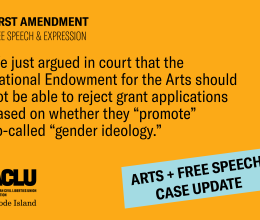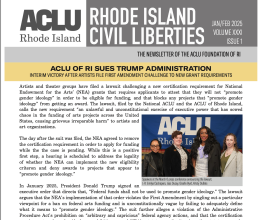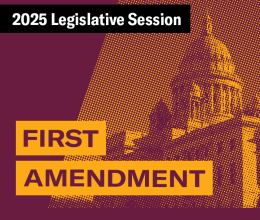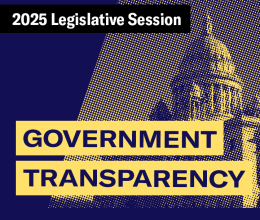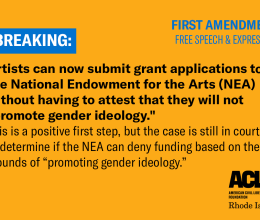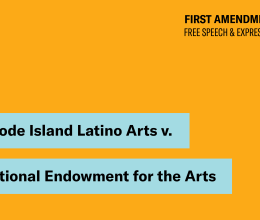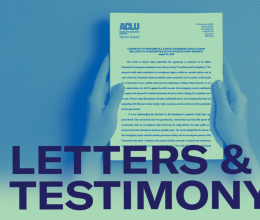The Rhode Island ACLU today filed a federal lawsuit challenging the constitutionality of a prayer mural addressed to “Our Heavenly Father” that is displayed in the auditorium of a Cranston public high school. The lawsuit, filed by RI ACLU volunteer attorneys Lynette Labinger and Thomas Bender, is on behalf of Jessica Ahlquist, a sophomore at Cranston High School West, who in the past year has spoken out against her school’s prayer display.
At a news conference announcing the filing of the lawsuit, the Rev. Dr. Donald Anderson, executive minister of the R.I. State Council of Churches, and Rabbi Peter Stein, who leads a congregation in Cranston, also expressed their opposition to the school’s display, calling it “inappropriate” and “exclusionary.”
Last July, after learning of the prayer display, the ACLU wrote to school officials asking that it be removed. In the hope of avoiding the need for litigation, the Affiliate waited eight months for the school committee to determine what to do. By a 4-3 vote last month, however, the school committee decided to keep the prayer, ignoring warnings about the cost of litigation and despite the school district’s ongoing and severe budgetary problems, which have led to layoffs and program cuts.
The lawsuit notes that the prayer, which is at least eight feet high and three feet wide, “is designed to be easily read by students attending programs in the auditorium.” The lawsuit alleges that Jessica Ahlquist “does not subscribe to the religious expression conveyed by the prayer and objects to being subjected to it as a requirement of attending school and a condition of attending school programs in the auditorium,” and that Jessica’s father, Mark, “does not believe his daughter should be subjected to a religious communication and display with which she does not agree as a condition of attending public school.”
The suit notes that a number of speakers at public hearings identified the prayer’s religious message as the reason for urging the school committee to maintain it, and also expressed anger and outrage at people like Jessica who questioned the prayer’s display. In fact, a day after the school committee’s March vote, Jessica was allowed to leave class early in response to concerns for her safety arising out of her opposition to the prayer.
The prayer apparently had its origins in or about 1960 when, at the school administration’s request, the prayer was written by a member of the student government. It was done at the same time the student body was also asked to choose a school creed, school colors and a school mascot. The prayer was painted onto the auditorium wall around 1963 and apparently recited by students for a period of time.
The suit argues that the prayer violates the First Amendment, and seeks a court order to prohibit its continued display at the school. The U.S. Supreme Court first ruled government-sponsored prayer in the public schools unconstitutional in 1962. Thirty years later, in a case handled by the RI ACLU, the Supreme Court also ruled unconstitutional the recitation of prayers at public school graduation ceremonies. In recent months, in recognition of the likelihood of litigation over the display, school officials have sought to minimize the display’s clear religious message, instead calling it “historic” and “artistic.”
Read the comments from those who participated in the news conference.

